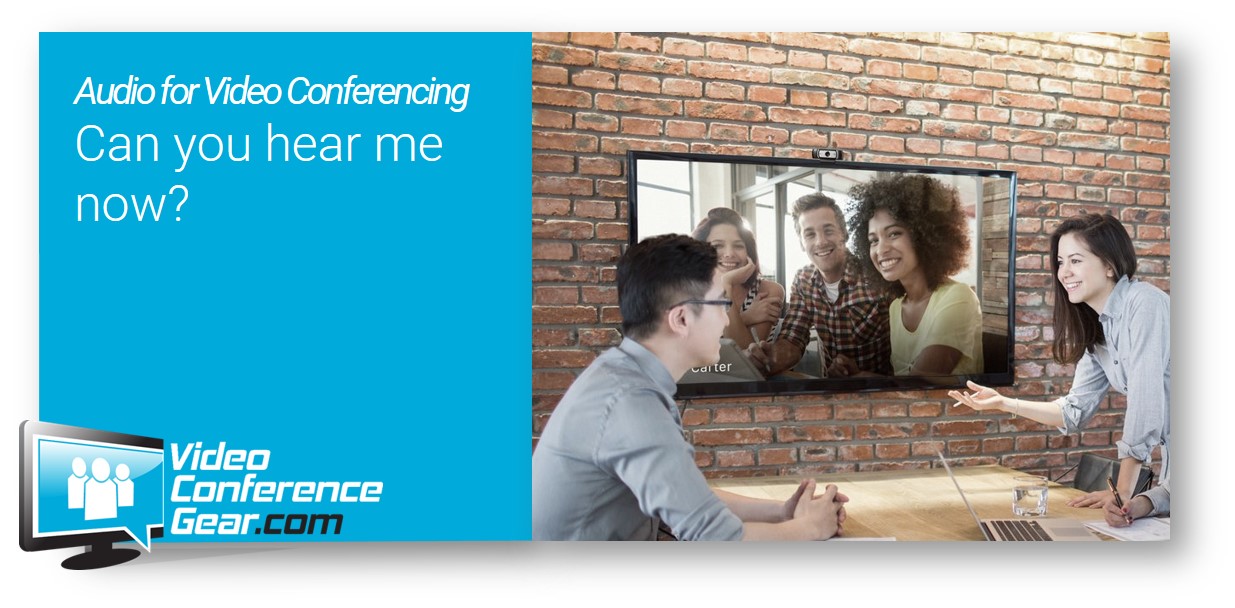Can you hear me now? An Audio Guide for Video Conferencing
Posted by Ryan PInke on 5/8/2018

I have to admit it, when it comes to video conferencing products, the first thing I always talk about is the camera. It's the default product that is demoed and asked about with my customers. I guess we all want to ensure we look at good as possible - just human nature.
But, audio is just as important for an overall experience within video conferencing. If it's hard to hear someone speak (either in the room or online), the meeting just won't be as productive. Also, having to press buttons for volume or to mute all the time, is just a pain.
That's why I thought it was time to put together a guide for video conferencing audio and the primary product types you will see out there, along with some of the advantages of each. But first, let's go over the primary features (and specs) you see with audio products.
Moving from the conference room speaker phone
One of the things most people notice about video conferencing audio products is they don't look like the traditional speakerphones of yesterday's conferencing rooms. Gone is the keypad and display. And even if there are a few "buttons" available, for volume, muting or special features, most of the controls are have migrated to an application (such as Zoom or Zoom Rooms) to control the audio.
Audio is fully integrated speaker and microphone
You we have now with video conferencing audio is a single product designed to handle both the speaker and the microphone functions. The shape varies depending on the product, it could be cube, a triangle, or a disk, but it functions the same - powered by speakers optimized for voice communications and microphones with noise canceling technology. These integrated units are digital, which allows them to automatically maximize the quality for everyone, either in room or online. In larger spaces, many audio products have extension mics available, which connect to the main unit via USB or other connection type - allowing the same product to be used in huddle rooms, standard sized rooms and large conferencing rooms.
Multiple connections
Almost every audio solution available on the market today will connect via USB to a computer (in our Zoom Rooms kits, that means connecting to the Intel NUC Skull Canyon). The majority also provide bluetooth connectivity also, allowing you to connect your phone or tablet directly to the audio unit. This is great for voice only communications, but can be an alternative setup for video conferencing also. Also, some products either have accessories or upgrades which allow connection to a phone system, either PSTN or IP telephony.
Video Conferencing Audio types
There are three primary product types of video conferencing audio, breaking down around the design as much as anything else.
Desktop Audio
Although we mostly work with our customers to enable their meeting spaces with video conferencing, that doesn't mean we ignore the desktop. The most popular solution today is headphones or earbuds (wired or bluetooth), with integrated microphone, or headphones with an external mic. We have desktop products available, which connect via USB and have the speaker and microphone integrated.
Tabletop Audio
Moving from a traditional speakerphone to video conferencing audio, the first products which hit the market has a similar look-and-feel, and placed in the center of the conference room table. They provided better quality at a lower price, but basically looked the same. It remains the most popular type of audio for conference rooms. You may not recognize the names of the market leaders in the market, but you can be certain, if it's on our site, they are market leaders. Tabletop audio products we provide include the following available from our online catalog.
Soundbar/Microphone Array Audio
An emerging area within video conferencing audio, and one we are excited about, is the explosion of soundbar/microphone array audio, specifically designed for use with audio conferencing. These products bring the quality of high end audio products (designed for home theatre use) and integrate them with microphone array technology previously only available with audio components. What we like most about this solution is just how clean your conference rooms look. Gone is the little "box" on the conference room table, and it's replaced by a soundbar that is installed either above or below your displays. Also, these products can also be utilized in larger rooms with two installed on opposite walls. The technology involved allows for full duplexed voice, giving a much more realistic "in the room" feeling for all participants. Also, they include advanced sound and white-noise cancellation, eliminating unwanted background noise. We like all these new products, because it provides so much flexibility for almost any room.
For larger rooms (include training rooms and classrooms), we usually install the audio components. Which includes a "mixer" for the audio components, ceiling mounted speaker and ceiling mounted/drop microphones. There are lots of options when we move from an audio product to audio components - and for many of these rooms, it ends up being designed specific to the use of the room. We have large room kits available online.
Sound Great, Look Great
High quality audio can make or break your video conference meetings. It may sound great in the rooms, but online the sound can be all static, or breaks up. Or if it's hard to hear the people online speaking, or even worse, every time someone moves within the room, it sounds like thunder - it's time to upgrade your audio. Looking great is only half the solution - you have to sound great too. No longer do you need to have a complicated audio solution to achieve that kind of quality, today's products give you professional quality voice audio, in a plug and play environment.
Make sure you check out all our audio solution - and remember, most of these are already included in a variety of our Room Kits, for Zoom Rooms, Skype for Business/Microsoft Meetings, and RingCentral.
